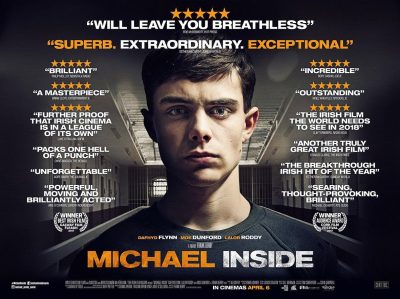“Michael Inside”. The Prison System in Ireland
A Movie Review

The most important aspect of this new Irish film is its cinematic approach to telling the story. Ireland has a long history of theatre and successful drama which spilled over into its film-making too. Irish films in the past have been worthy and wordy with directors more comfortable with theatrical styles than cinematic imagery. It was also difficult to achieve cinematic lift-off with the gravity of so many winners of the Nobel Prize in Literature. Ireland won four times in the 20th century: W. B. Yeats (1923), George Bernard Shaw (1925), Samuel Beckett (1969) and Séamus Heaney (1995), all of whom wrote plays. Not forgetting, of course, Lady Gregory, John Millington Synge, George Moore, Oscar Wilde and Seán O’Casey. The developing language of cinema filtered slowly into Irish film-making either for reasons of fear of audience reaction (more used to theatre) or a lack of an appreciation of the idea that sometimes less is more.
Michael Inside has at times an almost documentary feel to it in the way the prison and the prison officers are portrayed. They come across as empathetic and generally respectful of the prisoners. The director of Michael Inside, Frank Berry, stated the story-line was “researched with former prisoners” and authenticity was desired even to the point of using former prisoners as extras.
The use of the camera has a Tarkovskian feel with long takes, blurring and choreography before the camera. Some scenes like in the grandfather’s house are performed in front of a stationary camera with minimal lighting and wonderful blocking as actors move in and out of shot during the dialogue. Michael’s life outside of prison seems almost as oppressive as inside. Sparse dialogue, sparse rooms and ennui add to this feeling.
The tyranny of montage is felt though when Michael goes into his cell for the first time and sits down on the bottom bunk. This would have been a perfect moment to let the camera linger and linger to illustrate the timelessness of prison life. Steve McQueen, the British director, does this brilliantly in Hunger (2008) (also a great movie) when he has a fixed camera on one end of a long prison corridor pointed at a person washing the floor and stays on him until he finally gets to the other end. A similar very long take is used in the Irish Traveler film, Pavee Lackeen (2005) to illustrate the difficulty of such basic things as making a cup of tea as we see the young girl go outside and walk to a hose behind a metal fence, fill the bucket and walk back to the mobile home. However, in Michael Inside, it cuts all too soon in the prison cell to the next shot.
Cinema fans who liked A Prophet (French: Un prophète), the 2009 French prison drama-crime film directed by Jacques Audiard will also enjoy Michael Inside. Unlike A Prophet, the protagonist of Michael Inside is exposed to alternative paths for his future as a former prisoner who has studied for an MA and is progressing towards a PhD gives the inmates a talk on the importance of education. This is an important moment in the film as it demonstrates one way with which to break the cycle of violence and transgenerational incarceration. Indeed Michael plans to further his education despite the bias against former prisoners.
Michael Inside is a wonderful film about the Irish penal system, the sparseness of some working class lives and the potential for positive change. The irony of this depiction of working class poverty and hopelessness is the fact that the film is conceived, researched, and acted using the imagination, talents and experience of Irish working class people. It points to a new self-awareness and education happening in sections of Irish society that augur well for the future.
Caoimhghin Ó Croidheáin is an Irish artist, lecturer and writer. His artwork consists
of paintings based on contemporary geopolitical themes as well as Irish
history and cityscapes of Dublin. His blog of critical writing based on
cinema, art and politics along with research on a database of Realist
and Social Realist art from around the world can be viewed country by
country at http://gaelart.blogspot.ie/. He is a Research Associate of the Centre for Research on Globalization.















No comments:
Post a Comment